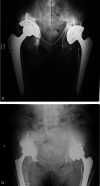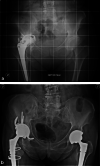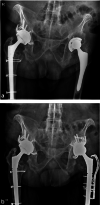Clinical and radiological outcomes of acetabular revision surgery with trabecular titanium cups in Paprosky type II and III bone defects
- PMID: 33675431
- PMCID: PMC7937008
- DOI: 10.1186/s10195-021-00571-1
Clinical and radiological outcomes of acetabular revision surgery with trabecular titanium cups in Paprosky type II and III bone defects
Abstract
Background: This prospective study aims to evaluate the mid-term clinical outcomes and radiographic stability of two different types of cementless trabecular titanium acetabular components in total hip revision surgery.
Methods: Between December 2008 and February 2017, 104 cup revisions were performed using trabecular titanium revision cups. Mean age of patients was 70 (range 29-90; SD 11) years. The majority of revisions were performed for aseptic loosening (86 cases, 82.69%), but in all the other diagnoses (18 cases), a significant bone loss (Paprosky type II or III) was registered preoperatively. Bone defects were classified according to Paprosky acetabular classification. We observed 53 type II defects and 42 type III defects. Cups were chosen according to the type of defect.
Results: Average follow-up was 91 (range 24-146) months. Mean Harris Hip Score (HHS) improved from 43.7 (range 25-70; SD 9) preoperatively to 84.4 (range 46-99; SD 7.56) at last follow-up. One (1.05%) cup showed radiographic radiolucent lines inferior to 2 mm and was clinically asymptomatic. One (1.05%) cup was loose and showed periacetabular allograft reabsorption. Kaplan-Meier survivorship was assessed to be 88.54% (95% CI 80.18-93.52%) at 71 months, with failure of the cup for any reason as the endpoint.
Conclusion: Trabecular titanium revision cups showed good clinical and radiographic results at mid-term follow-up in Paprosky type II and III bone defects.
Level of evidence: Level IV prospective case series.
Keywords: Acetabular bone loss; Acetabular reconstruction; Revision total hip arthroplasty; Trabecular titanium cup.
Conflict of interest statement
There are no competing interests to declare. F. Benazzo is a consultant and have a teaching contract with Lima-corporate. There are no competing interests for any of the other authors. The other authors have no disclosures.
Figures





Similar articles
-
Trabecular Titanium acetabular cups in hip revision surgery: mid-term clinical and radiological outcomes.Hip Int. 2018 Nov;28(2_suppl):61-65. doi: 10.1177/1120700018812992. Hip Int. 2018. PMID: 30755112
-
Long-term results of combined porous tantalum augments and titanium-coated cups for Paprosky type III bone defects in acetabular revision.Int Orthop. 2021 Jul;45(7):1699-1706. doi: 10.1007/s00264-021-05075-5. Epub 2021 May 21. Int Orthop. 2021. PMID: 34019127
-
[Acetabular revision for aseptic loosening in total hip arthroplasty using cementless cup and impacted morselized allograft].Rev Chir Orthop Reparatrice Appar Mot. 2007 May;93(3):255-63. doi: 10.1016/s0035-1040(07)90247-0. Rev Chir Orthop Reparatrice Appar Mot. 2007. PMID: 17534208 French.
-
Cementless acetabular revision: past, present, and future. Revision total hip arthroplasty: the acetabular side using cementless implants.Int Orthop. 2011 Feb;35(2):289-98. doi: 10.1007/s00264-010-1198-y. Epub 2011 Jan 14. Int Orthop. 2011. PMID: 21234562 Free PMC article. Review.
-
[Total hip arthroplasty revision surgery with migration of acetabular component to the subperitoneal space. Case report and literature review].Acta Ortop Mex. 2025 Mar-Apr;39(2):108-116. Acta Ortop Mex. 2025. PMID: 40335128 Review. Spanish.
Cited by
-
The Use of Highly Porous 3-D-Printed Titanium Acetabular Cups in Revision Total Hip Arthroplasty: A Systematic Review and Meta-Analysis.J Clin Med. 2025 Jan 31;14(3):938. doi: 10.3390/jcm14030938. J Clin Med. 2025. PMID: 39941609 Free PMC article. Review.
-
Acetabular revision with moderate-to-severe bone loss using a trabecular titanium cup-cage construct with impaction grafting.Orthop Rev (Pavia). 2025 Jun 16;17:140718. doi: 10.52965/001c.140718. eCollection 2025. Orthop Rev (Pavia). 2025. PMID: 40823272 Free PMC article.
-
Customized Additive Manufacturing in Bone Scaffolds-The Gateway to Precise Bone Defect Treatment.Research (Wash D C). 2023 Oct 9;6:0239. doi: 10.34133/research.0239. eCollection 2023. Research (Wash D C). 2023. PMID: 37818034 Free PMC article. Review.
-
Trabecular titanium cups in hip revision surgery: a systematic review of the literature.Ann Jt. 2023 Sep 19;8:36. doi: 10.21037/aoj-23-28. eCollection 2023. Ann Jt. 2023. PMID: 38529221 Free PMC article. Review.
References
-
- Levine B (2008) A new era in porous metals: applications in orthopaedics. In: MetFoam 2007—Proceedings of the 5th international conference on porous metals and metallic foams, p 251–254. https://doi.org/10.1002/adem.200800215
-
- Matharu GS, Judge A, Murray DW, Pandit HG. Trabecular metal versus non-trabecular metal acetabular components and the risk of re-revision following revision total hip arthroplasty: a propensity score-matched study from the national joint registry for England and Wales. J Bone Joint Surg Am. 2018;100:1132–1140. doi: 10.2106/JBJS.17.00718. - DOI - PubMed
MeSH terms
Substances
LinkOut - more resources
Full Text Sources
Other Literature Sources
Medical
Research Materials

